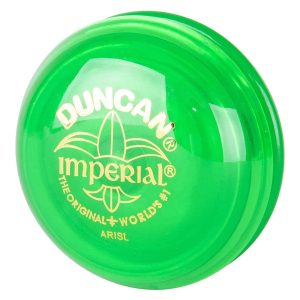Do You Yoyo?
Overview and History of One of America’s Favorite Toys
May 8, 2023
Yoyos are seemingly old fashioned and simple toys, basically a sphere at the end of a string; but did you ever wondered how and why these things were made and why they are still so popular?
The first yoyo was made in ancient Greece, and was made of wood and string, like its modern day counterpart. Later, it was popularized and then made of plastic by Pedro Flores, an American Filipino. This yoyo was called a Bangalore, before getting its iconic name that we know of today. Before the yoyo became a toy, it was used as a real weapon in the Philippines; it has sharp edges and studs attached to a giant rope and could be flung at the enemy.
 Now there are also many types of yoyos; one of them is nicknamed “The Imperial” and it is the oldest type of yoyo. Another type of yoyo, is “The Butterfly”, which was made in 1958 by William Katz. The toy company, Duncan made it a lot more popular that same year. This yoyo has a wide shape and is more popular than Imperials in the yoyo community. Lot of yoyos are made of plastic, being the toy ones, while some are made of wood, and others made of metal, like the “Metavity” is made of titanium which makes sparks on the ground. In addition there is another type of “modified” that is a cross between the Imperial and the Butterfly, having a bit of a wide angle compared to the Butterfly but the closed in fronts that the Imperials have This shape was made in the early era of yoyos.
Now there are also many types of yoyos; one of them is nicknamed “The Imperial” and it is the oldest type of yoyo. Another type of yoyo, is “The Butterfly”, which was made in 1958 by William Katz. The toy company, Duncan made it a lot more popular that same year. This yoyo has a wide shape and is more popular than Imperials in the yoyo community. Lot of yoyos are made of plastic, being the toy ones, while some are made of wood, and others made of metal, like the “Metavity” is made of titanium which makes sparks on the ground. In addition there is another type of “modified” that is a cross between the Imperial and the Butterfly, having a bit of a wide angle compared to the Butterfly but the closed in fronts that the Imperials have This shape was made in the early era of yoyos. 
Tricks are the basis of why yoyos are so popular nowadays. Most competitive yoyo players use the butterfly type yoyos due to the fact that they can do string tricks compared to imperials which don’t have the aerodynamic opening that the butterfly has. Butterflies were made with string tricks in mind, unlike the Imperial or modified yoyos.
Also of importance are the yoyo strings. Most strings are made of cotton, being more durable then stuff like yarn, and having more bounce to it then yarn string. There are also polyester strings, which are more favorable for the intermediate and high ranking yoyo players. Bearings are also an important part of the yoyo ‘s structure. There are two bearings, an unresponsive and a responsive bearing: The unresponsive bearing doesn’t allow the yoyo to come back up to you unless you do a trick called the bind, but can do a lot of other tricks. The responsive bearing on a yoyo is what makes it come back to your hand with a tug. There are even yoyo gloves meant to protect your finger from string tension as well as from the impact of the yoyo, or to prevent string burns for your other hand while doing two-handed string tricks. Another key component used in tricks are plastic counterweights. They are used in one of the styles of yoyoing.
Now lets go over the styles of yoyos, 1A is your typical 1 yoyo and nothing more, still a prominent style though, as long as yoyos survive, 1A will always stay. The 2A is 2 yoyo looping tricks, this style also has a counterpart, 3A which also uses 2 yoyos, but 2A does loops and 3A is string tricks with both yoyos. The 4A are off-string yoyo tricks, where the yoyo falls off of its string and you can do tricks with it. I would say this is the hardest style of yoyoing because all of the other ones do come back to your hand and the string stays on. The 5A is where the yoyo has a counterweight and you have to hold it in a whole different way, you can do interesting and fun tricks with this 5A style. A counterweight is like a little dice or object (has to be small) that you can use for tricks in the freehand style. Last, there is an unofficial “6A” style where it would play like 5A but expect there is no counterweight, its another yoyo, which is very similar to the Poi performance in New Zealand, where two wood balls would be together on a string, just like this “6A” style.
though, as long as yoyos survive, 1A will always stay. The 2A is 2 yoyo looping tricks, this style also has a counterpart, 3A which also uses 2 yoyos, but 2A does loops and 3A is string tricks with both yoyos. The 4A are off-string yoyo tricks, where the yoyo falls off of its string and you can do tricks with it. I would say this is the hardest style of yoyoing because all of the other ones do come back to your hand and the string stays on. The 5A is where the yoyo has a counterweight and you have to hold it in a whole different way, you can do interesting and fun tricks with this 5A style. A counterweight is like a little dice or object (has to be small) that you can use for tricks in the freehand style. Last, there is an unofficial “6A” style where it would play like 5A but expect there is no counterweight, its another yoyo, which is very similar to the Poi performance in New Zealand, where two wood balls would be together on a string, just like this “6A” style.
 There are also auto return yoyos, which have a clutch system, famous examples of these yoyos are: the “Yomega Brain”, the Duncan reflex and some blazing team yoyo called the “Beast Wrangler”. There are also yoyos that you can grab while it’s spinning, two examples of these are the nine dragons and the “tornado strike” another blazing team yoyo. These yoyos are always unresponsive, unlike the tornado strike, which is responsive but is not super responsive, meaning the spinning still works as a system. So You can see that the yoyo is more complicated that it appears. There are many to choose from to suit any level of interest or skill.
There are also auto return yoyos, which have a clutch system, famous examples of these yoyos are: the “Yomega Brain”, the Duncan reflex and some blazing team yoyo called the “Beast Wrangler”. There are also yoyos that you can grab while it’s spinning, two examples of these are the nine dragons and the “tornado strike” another blazing team yoyo. These yoyos are always unresponsive, unlike the tornado strike, which is responsive but is not super responsive, meaning the spinning still works as a system. So You can see that the yoyo is more complicated that it appears. There are many to choose from to suit any level of interest or skill.

















